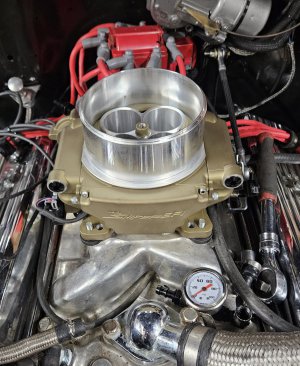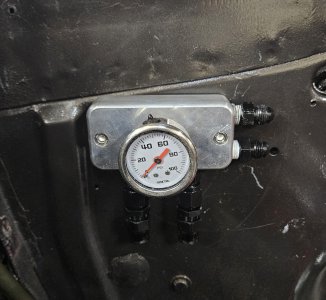- Joined
- Jul 5, 2014
- Messages
- 2,772
Wasn't sure where to post this but since it's on my car I guess this is probably the best place.
I'm in the middle of installing a holley sniper fuel injection of my 55 chevy. There is a thread on the tri-5 chevy forum about the sniper and the OP had a lot of problems with his system. He has his battery in the trunk like I do and ran his power for the sniper off the starter solenoid terminal. That's exactly how I planned to do it. The instructions are very clear with the sniper. Run both the power and ground wires off the battery directly, but again my battery is in the trunk.
So rather than just going by something I someone said on the internet with him saying he had problems running power from the starter terminal I called holley. It's free so why not.
After a 15 minute hold I got to talk with someone in sniper tech support. I told him where my battery was and he said to run a separate 10awg wire to the battery. I have a ground cable from the battery run to a bell housing bolt, then the body and frame are grounded from that. He said that would be fine but the separate wire for power to the battery would prevent "Flyback" from the starter. I looked up electrical flyback and found this: “Flyback Voltage Spike” occurs when the supply current to an inductive load such as a solenoid is interrupted"
Ok, so my question is with the new power wire running directly to the battery to the same place on the battery post wouldn't the flyback also travel back down the 10 awg wire also? Or is the battery acting as a buffer to absorb the spike?
Now I just realized I need to figure out some kind of fuse or circuit breaker for the new wire. I just can't see running a heavy gauge power wire from the battery to the injection through the car without some kind of overload protection. If the 10awg wire shorted somehow it could do a lot of damage.
I wish I had a crystal ball so I would know ahead of time what parts I will need so I didn't have to wait for parts to come in.
Hurry up and wait, story of my life it seems.
I'm in the middle of installing a holley sniper fuel injection of my 55 chevy. There is a thread on the tri-5 chevy forum about the sniper and the OP had a lot of problems with his system. He has his battery in the trunk like I do and ran his power for the sniper off the starter solenoid terminal. That's exactly how I planned to do it. The instructions are very clear with the sniper. Run both the power and ground wires off the battery directly, but again my battery is in the trunk.
So rather than just going by something I someone said on the internet with him saying he had problems running power from the starter terminal I called holley. It's free so why not.
After a 15 minute hold I got to talk with someone in sniper tech support. I told him where my battery was and he said to run a separate 10awg wire to the battery. I have a ground cable from the battery run to a bell housing bolt, then the body and frame are grounded from that. He said that would be fine but the separate wire for power to the battery would prevent "Flyback" from the starter. I looked up electrical flyback and found this: “Flyback Voltage Spike” occurs when the supply current to an inductive load such as a solenoid is interrupted"
Ok, so my question is with the new power wire running directly to the battery to the same place on the battery post wouldn't the flyback also travel back down the 10 awg wire also? Or is the battery acting as a buffer to absorb the spike?
Now I just realized I need to figure out some kind of fuse or circuit breaker for the new wire. I just can't see running a heavy gauge power wire from the battery to the injection through the car without some kind of overload protection. If the 10awg wire shorted somehow it could do a lot of damage.
I wish I had a crystal ball so I would know ahead of time what parts I will need so I didn't have to wait for parts to come in.
Hurry up and wait, story of my life it seems.



